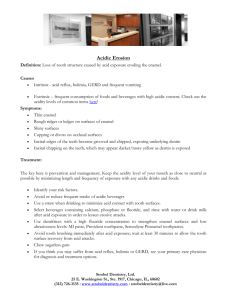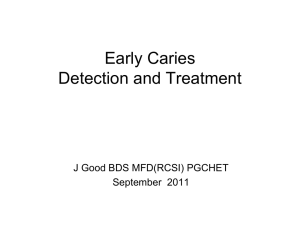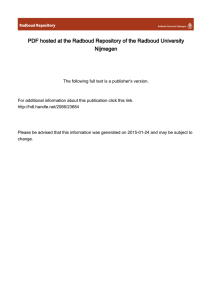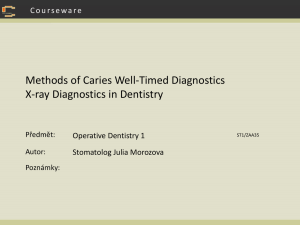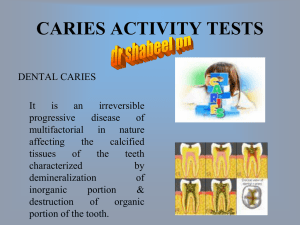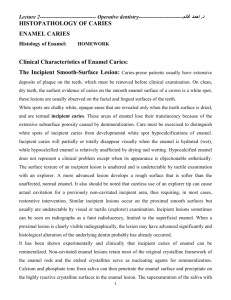Type of dental caries
advertisement
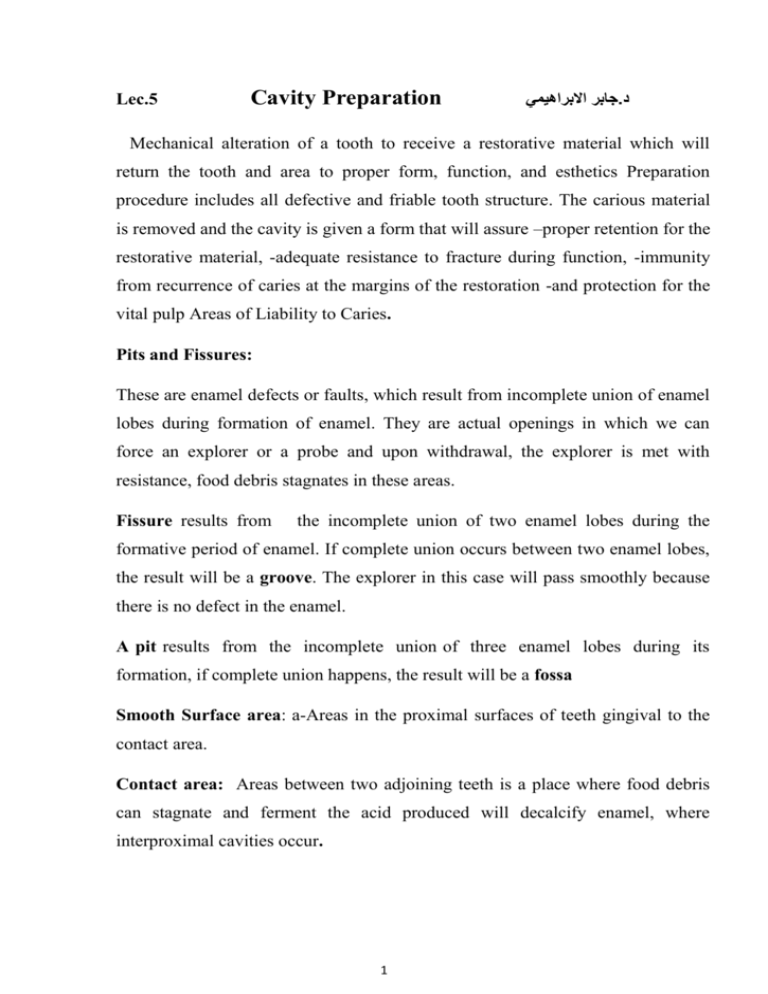
Lec.5 Cavity Preparation جابر االبراهيمي.د Mechanical alteration of a tooth to receive a restorative material which will return the tooth and area to proper form, function, and esthetics Preparation procedure includes all defective and friable tooth structure. The carious material is removed and the cavity is given a form that will assure –proper retention for the restorative material, -adequate resistance to fracture during function, -immunity from recurrence of caries at the margins of the restoration -and protection for the vital pulp Areas of Liability to Caries. Pits and Fissures: These are enamel defects or faults, which result from incomplete union of enamel lobes during formation of enamel. They are actual openings in which we can force an explorer or a probe and upon withdrawal, the explorer is met with resistance, food debris stagnates in these areas. Fissure results from the incomplete union of two enamel lobes during the formative period of enamel. If complete union occurs between two enamel lobes, the result will be a groove. The explorer in this case will pass smoothly because there is no defect in the enamel. A pit results from the incomplete union of three enamel lobes during its formation, if complete union happens, the result will be a fossa Smooth Surface area: a-Areas in the proximal surfaces of teeth gingival to the contact area. Contact area: Areas between two adjoining teeth is a place where food debris can stagnate and ferment the acid produced will decalcify enamel, where interproximal cavities occur. 1 Walls and Angle of Cavities: Black gave the following rules for naming the internal parts of cavities. Rule I : The walls take the names of the adjacent tooth surfaces. Rule II: That wall of a prepared cavity, which is occlusal to the pulp, and in a plane at right angles to the long axis of the tooth, is called the pulpal wall or floor. In case the pulp of the tooth is removed, and the cavity thus extended to include the pulp chamber; that wall is called the sub-pulpal wall. Rule III: The wall which is parallel to the long axis of the tooth and approximates the pulp, is called the axial wall. Rule IV: All the line angles are formed by the junction of two walls along a line, and are named by combining the names of the walls joining to form the angle. Rule V: All point angles are formed by the junction of three walls at a point, and are named by joining the names of the walls forming the angle. The Cavo-surface Angle: Is the angle formed by the junction of the wall of the cavity with the surface of the tooth. The cavo-surface angle of a cavity will be of enamel, while in cavities present in the root of teeth, which are exposed due to gingival recession, the cavo- surface angle will be cementum. The enamel margin includes the whole outline of the prepared cavity. The Dentino-Enamel Junction: Also called amelo- dental junction, is the line of junction of dentin and enamel as it appears in the walls of the prepared cavities. The Enamel Wall: Is that portion of a prepared cavity, which consists of enamel, It includes the thickness of the enamel from the dentino-enamel junction to the cavo-surface angle. 2 The Dentin wall: that portion of the wall of a prepared cavity, which consists of dentin. Pulpal Wall: The wall of the prepared cavity which is occlusal to the pulp and in a horizontal plane at right angle to the long axis of the tooth. Axial Wall: Any wall in the prepared cavity, which is parallel to the long axis of the tooth. 3 Dental caries Dental caries is an irreversible microbial disease of the calcified tissues of the teeth, characterized by demineralization of the inorganic portion and destruction of the organic substance of the tooth, which often leads to cavitation. Pathway of dental caries. Enamel: First component of enamel to be involved in carious process is the interprismatic substance. The disintegrating chemicals will proceed via the interprismatic substance, causing the enamel prism to be undermined. The resultant caries involvement in enamel will have cone shape. In concave surface (pit and fissures) base towards DEJ. In convex surfaces (smooth surface) base away from DEJ. 4 Dentine: First component to be involved in dentin is Protoplasmic extension within the dentinal tubules. These protoplasmic extensions have their maximum space at the DEJ, but as they approach the pulp chamber and root canal walls, the tubules become more densely arrange with fewer interconnections. ■ So caries cone in dentin will have their base towards DEJ. Decay starts in enamel then it involves the dentin. Wherever the caries cone in enamel is larger or at least the size as that of dentin, it is called forward decay (pit decay). However the carious process in dentin progresses much faster than in enamel so the cone in dentin tends to spread laterally creating undermined enamel. In addition decay can attack enamel from its dentinal side. At this stage it becomes backward decay. 5 Classification of dental caries according to anatomical sites 1. Pit and fissure caries (OCCLUSAL CARIES) Pit and fissure caries of the primary type develops in the occlusal surface of molar and premolar, in the buccal and lingual surface of the molar and in the palatal surface of the maxillary incisors. Shape, morphological variation and depth of pit and fissures contribute to their high susceptibility to caries. Enamel in the extreme depth is very thin or occasionally absent and thus allows the exposure of dentin. Pit and fissures affected by early caries may appear brown or black and will feel slightly soft and ‘catch’ a fine explorer point. Entry site may appear much smaller than actual lesion, making clinical diagnosis difficult. Carious lesion of pits and fissures develop from attack on their walls. In cross section, the gross appearance of pit and fissure lesion is inverted V with a narrow entrance and a progressively wider area of involvement closer to the DEJ. 2. Smooth surface caries Less favorable site for plaque attachment, usually attaches on the smooth surface that are near the gingiva or are under proximal contact. In very young patients the gingival papilla completely fills the interproximal space under a proximal contact and is termed as col. Also crevicular spaces in them are less favorable habitats for s.mutans. Consequently proximal caries is less lightly to develop where this favorable soft tissue architecture exists. 6 3. Linear enamel caries Linear enamel caries ( odontoclasia ) is seen to occur in the region of the neonatal line of the maxillary anterior teeth. The line, which represents a metabolic defect such as hypocalcemia or trauma of birth, may predispose to caries, leading to gross destruction of the labial surface of the teeth. Morphological aspects of this type of caries are atypical and results in gross destruction of the labial surfaces incisor teeth. 4. ROOT SURFACE CARIES The proximal root surface, particularly near the cervical line, often is unaffected by the action of hygiene procedures, such as flossing, because it may have concave anatomic surface contours (fluting) and occasional roughness at the termination of the enamel. These conditions, when coupled with exposure to the oral environment (as a result of gingival recession), favor the formation of mature, caries-producing plaque and proximal root-surface caries. Root-surface caries is more common in older patients. Caries originating on the root is alarming because 1. It has a comparatively rapid progression 2. It is often asymptomatic 3. It is closer to the pulp 4. It is more difficult to restore The root surface is refer the enamel and readily allows plaque formation in the absence of good oral hygiene. The cementum covering the root surface is extremely thin and provides little resistance to caries attack. 7 Root caries lesions have less well-defined margins, tend to be U-shaped in cross sections, and progress more rapidly because of the lack of protection from and enamel covering. 8
